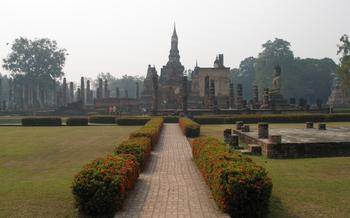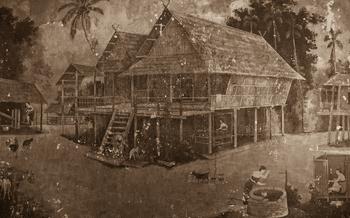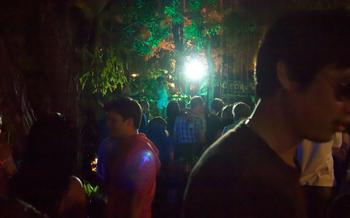
Wat Phra Borommathat Chaiya Worawihan
- Wat Phra Borommathat Chaiya Worawihan: A Historical and Cultural Masterpiece
- Location and Accessibility
- Temple Grounds and Layout
- Buddha Images and Statues
- Mural Paintings and Artwork
- Monastery and Living Quarters
- Local Beliefs and Practices
- Visitor Etiquette and Respect
- Guided Tours and Local Guides
- Photography and Social Media
- Insider Tip: Hidden Gems and Secret Spots
Wat Phra Borommathat Chaiya Worawihan: A Historical and Cultural Masterpiece
Wat Phra Borommathat Chaiya Worawihan stands as a testament to the rich history and cultural heritage of Thailand, dating back to the 12th century. This magnificent temple is considered one of the most significant historical and cultural sites in the Surat Thani province. It is believed that the temple was built during the reign of King Srivikrama Rajasimha and has undergone several renovations and expansions over the centuries. The temple's architectural grandeur, religious importance, and cultural significance have made it a popular destination for pilgrims, history buffs, and tourists alike.
Location and Accessibility
Wat Phra Borommathat Chaiya Worawihan is situated in the heart of Chaiya district, Surat Thani province, Thailand. It is strategically located within walking distance from the bustling city center, offering easy access to both local residents and tourists. To reach the temple, visitors can take a leisurely stroll from their nearby accommodations or utilize the convenient public transportation options available.
From Surat Thani city, one can catch a local bus or songthaew (shared taxi) that directly serves Chaiya district. The journey takes approximately 1 hour and 30 minutes, providing a scenic ride through the picturesque countryside. Upon arrival in Chaiya, visitors can simply ask for directions to the temple, as it is a well-known landmark in the area.
The temple is situated in a serene and tranquil neighborhood, away from the hustle and bustle of the main roads. This peaceful ambiance enhances the spiritual and cultural experience for visitors seeking a moment of respite and contemplation. Moreover, the temple's proximity to other notable attractions in Chaiya, such as the Chaiya National Museum and the Chaiya Market, makes it an ideal starting point for exploring the district's rich history and vibrant local culture.
For those with limited mobility, the temple is wheelchair and stroller accessible, ensuring that everyone can comfortably navigate its grounds and appreciate its architectural wonders. Designated parking spaces are available for visitors arriving by private vehicles, adding to the convenience of accessibility.
Temple Grounds and Layout
The temple complex of Wat Phra Borommathat Chaiya Worawihan is extensive, covering an area of over 20 acres. The layout is well-planned and symmetrical, with a central axis running from the main entrance to the ordination hall. The main structures are arranged around this axis, including the main chedi, the ordination hall, and the viharns.
The main chedi is the most prominent structure in the temple complex. It is a large, bell-shaped chedi with a distinctive spire. The chedi is surrounded by a series of smaller chedis, which are arranged in a concentric circle. The ordination hall is located to the east of the main chedi. It is a large, rectangular building with a high roof. The ordination hall is used for ceremonies and rituals, such as ordinations and weddings.
The viharns are located to the north and south of the main chedi. They are large, open-sided halls with a high roof. The viharns are used for meditation and other religious activities. The temple complex also includes a number of other buildings, such as a library, a school, and a museum. These buildings are located around the perimeter of the complex.
The layout of Wat Phra Borommathat Chaiya Worawihan is designed to create a sense of tranquility and peace. The open spaces and the symmetrical arrangement of the buildings create a harmonious and inviting atmosphere. The temple is a popular destination for pilgrims and tourists alike, who come to admire its beauty and to experience its serene atmosphere.
Buddha Images and Statues
The Wat Phra Borommathat Chaiya Worawihan is home to a remarkable collection of Buddha images and statues, each holding immense religious and historical significance. The most revered image is the Phra Borommathat Chaiya, a large and imposing statue of Buddha seated in a meditation posture. This iconic image is believed to date back to the 13th century and is considered one of the most sacred Buddha statues in Thailand.
In addition to the Phra Borommathat Chaiya, the temple houses numerous other Buddha images and statues of varying sizes and styles. These statues represent different periods of Thai history and showcase the evolution of Buddhist art and iconography. Visitors can marvel at the intricate details, serene expressions, and symbolic hand gestures of these sacred figures.
The placement of the Buddha images within the temple is also significant. The main Buddha image is typically positioned in the central shrine room, while other statues are placed in smaller shrines, viharns, or along the temple grounds. The arrangement of the statues reflects Buddhist cosmology and the hierarchy of deities and bodhisattvas.
Many of the Buddha images and statues at Wat Phra Borommathat Chaiya Worawihan are associated with stories and legends that add to their allure. Some are believed to have miraculous powers or to have been created by renowned artisans. Devotees often pay homage to these statues, offering prayers, flowers, and incense to seek blessings and good fortune.
Whether you are a devout Buddhist, a history enthusiast, or simply an admirer of beautiful artwork, the Buddha images and statues at Wat Phra Borommathat Chaiya Worawihan are sure to leave a lasting impression. Take your time to explore the temple grounds, admire the sacred figures, and immerse yourself in the rich cultural heritage of Thailand.
Mural Paintings and Artwork
The walls of Wat Phra Borommathat Chaiya Worawihan are adorned with intricate mural paintings that depict scenes from the life of Buddha, the Jataka tales, and Thai history. These murals are not only visually stunning but also hold immense historical and cultural significance.
The paintings were created using traditional techniques and feature vibrant colors that have remained remarkably well-preserved over the centuries. The artists who created these masterpieces demonstrated exceptional skill and attention to detail, capturing the essence of each story through their brushstrokes.
The murals serve as a valuable source of information about the beliefs, customs, and traditions of the people of Chaiya during the time they were created. They offer a glimpse into the daily life, religious practices, and social interactions of the community.
In recent years, efforts have been made to conserve and restore these precious artworks. Conservationists have carefully cleaned and repaired the murals, ensuring that they can be enjoyed by future generations.
Visitors to Wat Phra Borommathat Chaiya Worawihan should take the time to admire the exquisite mural paintings that adorn its walls. These works of art are not only beautiful but also provide a fascinating glimpse into the history and culture of Thailand.
Monastery and Living Quarters
The monastery plays a crucial role in the life of Wat Phra Borommathat Chaiya Worawihan, providing a sanctuary for monks and novices to pursue their spiritual studies and devote themselves to Buddhist teachings. The living quarters within the monastery are designed to facilitate a simple and contemplative lifestyle, allowing the monks to focus on their spiritual pursuits.
The living quarters typically consist of humble rooms or cells, where each monk or novice resides. These rooms are often sparsely furnished, with a bed, a desk, and a few personal belongings. The simplicity of the living arrangements reflects the Buddhist emphasis on detachment from material possessions and the pursuit of a higher spiritual purpose.
Daily routines within the monastery are structured around meditation, prayer, and study. Monks and novices rise early for morning prayers and meditation, followed by a communal breakfast. The rest of the day is dedicated to studying Buddhist scriptures, practicing meditation, and performing various tasks related to the upkeep of the temple.
Visitors to the monastery are often struck by the serene atmosphere and the sense of peace that permeates the living quarters. The monks and novices are known for their kindness and hospitality, and they are always willing to share their knowledge and insights with visitors who are interested in learning more about Buddhism and the monastic way of life.
Local Beliefs and Practices
The Wat Phra Borommathat Chaiya Worawihan is deeply embedded in the local culture and traditions of Surat Thani. Devotees and pilgrims from the surrounding areas visit the temple to pay homage to the Buddha and seek blessings. Several local beliefs and practices are associated with the temple, reflecting the profound respect and reverence it holds in the community.
One of the most significant beliefs is the power of making merit at the temple. Devotees often make offerings of flowers, candles, and incense to the Buddha images, believing that these acts of generosity will bring them good fortune and blessings. They also participate in merit-making activities such as donating to the temple's upkeep, offering food to the monks, and observing Buddhist precepts.
Another local practice is the belief in the healing powers of the temple's Buddha images. Devotees who are suffering from illnesses or seeking relief from physical ailments often visit the temple to pray to the Buddha for healing. They may touch or rub the Buddha images, believing that the sacred energy of the Buddha will help alleviate their suffering.
Furthermore, the temple is considered a sacred place for meditation and spiritual reflection. Many locals visit the temple to find peace and tranquility amidst the hustle and bustle of daily life. They meditate in the serene surroundings of the temple grounds, seeking inner peace and spiritual enlightenment.
Overall, the Wat Phra Borommathat Chaiya Worawihan is not just a historical and architectural marvel but also a vibrant center of local beliefs and practices. The temple's sacred atmosphere and spiritual significance make it a revered destination for devotees and pilgrims, who come to pay homage to the Buddha, seek blessings, and find solace in its tranquil surroundings.
Visitor Etiquette and Respect
When visiting Wat Phra Borommathat Chaiya Worawihan, it is essential to adhere to proper etiquette and demonstrate respect for the temple's religious significance and cultural heritage. Here are some guidelines to follow:
-
Dress Code: Visitors should dress modestly and respectfully. Avoid wearing shorts, tank tops, or revealing clothing. It is customary to cover your shoulders and knees when entering the temple grounds.
-
Behavior: Maintain a respectful demeanor while visiting the temple. Avoid loud talking, laughing, or engaging in disruptive activities. Be mindful of your actions and movements, ensuring not to disturb the tranquility of the temple environment.
-
Customs and Traditions: Familiarize yourself with Buddhist customs and traditions before visiting the temple. Understand the significance of bowing or paying respect to Buddha images and monks. Avoid touching or pointing at Buddha images, as this is considered disrespectful.
-
Photography: Photography is generally allowed within the temple grounds, but it is essential to be respectful and mindful of others. Avoid using flash photography, as it can be disruptive to worshippers and damage the temple's artwork. Ask permission before photographing monks or other visitors.
Guided Tours and Local Guides
At Wat Phra Borommathat Chaiya Worawihan, guided tours are available to enhance your temple experience. These tours offer a wealth of knowledge and insights into the temple's history, architecture, and significance. Local guides, who are well-versed in the temple's history and traditions, lead these tours. They share fascinating stories and anecdotes that bring the temple's past to life.
Booking a guided tour is highly recommended for first-time visitors or those seeking a more in-depth understanding of the temple. Guides can customize the tour to suit your interests, whether you're interested in the temple's architecture, religious significance, or local customs.
The cost of a guided tour varies depending on the group size, duration, and level of customization. You can book tours through local tour operators or directly at the temple. It's advisable to make reservations in advance, especially during peak tourist season, to secure your spot.
During the guided tour, you'll gain insights into the temple's unique architectural features, the stories behind the Buddha images, and the significance of various rituals and ceremonies. Your guide will also point out hidden gems and lesser-known areas of the temple that you might miss if exploring independently.
Whether you're a history buff, a cultural enthusiast, or simply seeking a deeper connection with the temple's spiritual essence, a guided tour with a knowledgeable local guide will elevate your visit to Wat Phra Borommathat Chaiya Worawihan.
Photography and Social Media
Photography and social media play a significant role in sharing the beauty and significance of Wat Phra Borommathat Chaiya Worawihan with the world. Visitors are welcome to capture the stunning architecture, intricate murals, and serene atmosphere of the temple through photos and videos. However, it is important to respect the sanctity of the temple and the privacy of monks and other visitors.
When taking photos, avoid using flash as it can be disruptive during ceremonies or meditation. Be mindful of the angles and positions from which you take photos to ensure that you are not capturing people in an unflattering or disrespectful manner. It is also important to refrain from taking photos of monks without their permission.
Social media platforms offer a wonderful opportunity to share your experiences and insights about Wat Phra Borommathat Chaiya Worawihan with others. When posting photos or videos, be sure to use relevant hashtags and geotags to connect with other travelers and enthusiasts. Sharing your experiences can help raise awareness about this hidden gem and encourage others to visit and appreciate its beauty and significance.
Insider Tip: For unique and Instagram-worthy shots, venture beyond the main temple complex and explore the surrounding gardens and walkways. You might stumble upon hidden murals or statues tucked away from the crowds, providing a tranquil and picturesque backdrop for your photos.
Insider Tip: Hidden Gems and Secret Spots
Beyond the main attractions, Wat Phra Borommathat Chaiya Worawihan holds hidden gems waiting to be discovered. Venture off the beaten path to find a secluded spot beneath a majestic Bodhi tree, where you can sit in tranquility and meditate. Explore the temple's tranquil gardens, where vibrant flowers bloom and ancient trees offer shade. Discover hidden murals tucked away in quiet corners, depicting stories from Buddhist mythology. As the sun rises, capture the temple's silhouette against the golden sky, casting an ethereal glow upon the grounds. And as the day ends, witness the sunset bathe the temple in a warm amber light, creating a magical atmosphere. These hidden gems offer a unique perspective on the temple's beauty and serenity, allowing you to connect with its spiritual essence.



